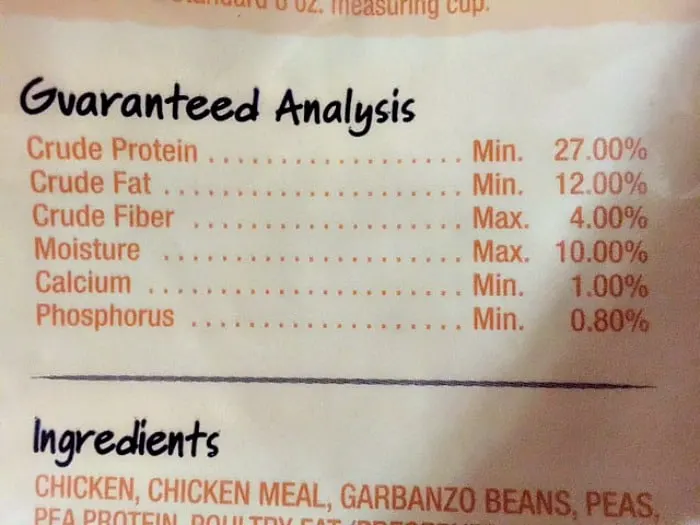
How many times have you found yourself in the grocery store carefully reading the labels on the various items that you purchase? Think about the times you’ve spent reading about ingredients you should or shouldn’t eat, and those items that will give you that extra boost of nutrients. So, when you think about it, why should our dogs be any different?
Pet owners are now starting to become more aware and critical of the ingredients found in dog food in hopes to give their furry family member the best and most healthy food possible. With that said, the list of ingredients on the back of the dog food can seem rather intimidating and confusing to read.
- What should you be looking for?
- What are the best ingredients?
- What are the ones to avoid?
Let’s take a closer look at how to read the ingredients on your dog food so you can feel more informed when shopping for your furry family member:
Try to Look Past the Catch Lines on the Front
Dog food manufacturers realize that pet owners are becoming more critical and aware of what’s in the food they are buying so, with that said, they are starting to paste all kinds of claims on the front. Now obviously some of these will be important, but it shouldn’t be what you base your decision on.
Taking a look at the front of the dog food bag that says it’s “gluten-free” just isn’t enough, you’ll still want to read all of the ingredients on the back. Just because there isn’t gluten in it, doesn’t mean that it’s a “safe” choice for your animal. You need to look at the full picture.

Pay Attention to the “Guaranteed Analysis”
The guaranteed analysis is a portion that appears on the ingredients list and is the labeled percentages of fat, moisture, fiber, and crude protein. This guarantee is mandatory and helps you to figure out if it’s ideal for your animal. It also helps you figure out how much your dog needs to be eating. Keep mind, there will be differences when comparing a wet food to a dry food.
Question “Organic” Ingredients
Another trend with dog food as of late is to claim that the ingredients are “organic”. Obviously, this makes it sound healthier and there is the belief that these ingredients haven’t gone through any potentially harmful chemical alterations. The same goes for foods that are “holistic”. In order for this claim to be true you want to look for the official organic label on the food from a reputable organization like the USDA. Without that label, the claim can’t be backed up.
What Kind of Protein is Included
One of the most important aspects of dog food is the protein contained in it. Protein is needed in your dog’s diet, so this isn’t something you want to skimp out on. Typical sources of protein are lamb, fish, beef, and chicken. If your dog needs an extra boost of protein, opt for a chicken-based food. When a protein reads as “meal” for example “beef meal” or “chicken meal”, then it has been dehydrated which contains less water and more of the actual meat.

Does Your Dog Have Allergies
Just like humans, our family pets can have allergies too. If your dog has been known to have allergies to certain ingredients, you will obviously want to avoid giving them food that contains it. Typical signs that a dog may be allergic to an ingredient in the food they are eating include:
- an itchy rear end
- constantly licking their feet
- redness on their feet or tummy
- chronic gas
- inflammation and redness of the ears
- itchy ears
- chronic diarrhea
While every dog is different, there are some allergens that are more common than others. These include fish, rabbit, dairy, pork, beef, soy, egg, lamb, wheat, and chicken. If your dog does have allergies, you may want to speak to your vet about what they recommend.
Don’t Go by the Price Alone
It’s very easy to assume that the more expensive the food is, the higher the quality of the ingredients. This isn’t always the case. Instead, you will want to look at the label closely and examine the ingredients listed and not the price tags.

Ingredients are Listed by Weight
Keep in mind, as you read the list of ingredients they are listed by weight. The ingredients at the top of the list have more weight to them, so that’s where you want to see the meat listed. If the protein/meat is listed near the middle or bottom of the list, then you know there isn’t much in the food.
Becoming an Informed Shopper
Following these Happy Pooch tips will help you to become a more informed shopper when it comes to dog food, which will allow you to find the very best food out there for your loyal companion.
A good YouTuber to watch that explains commercial dog food and what to look for is Dr. Rea. Look under Playlists to find the dog food playlist that applies to your situation. Here’s her channel: https://www.youtube.com/@AnimalDocRea
Jeffery Roberts
 Jeffery is a pet enthusiast and volunteer at his local pet shelter. His passion for animals started at an early age and through his work on becoming a veterinary student he understands and cares for pets of all species. Jeffery currently writes for The Happy Pooch and has 2 cats, a bird and a dog named Lucy.
Jeffery is a pet enthusiast and volunteer at his local pet shelter. His passion for animals started at an early age and through his work on becoming a veterinary student he understands and cares for pets of all species. Jeffery currently writes for The Happy Pooch and has 2 cats, a bird and a dog named Lucy.
